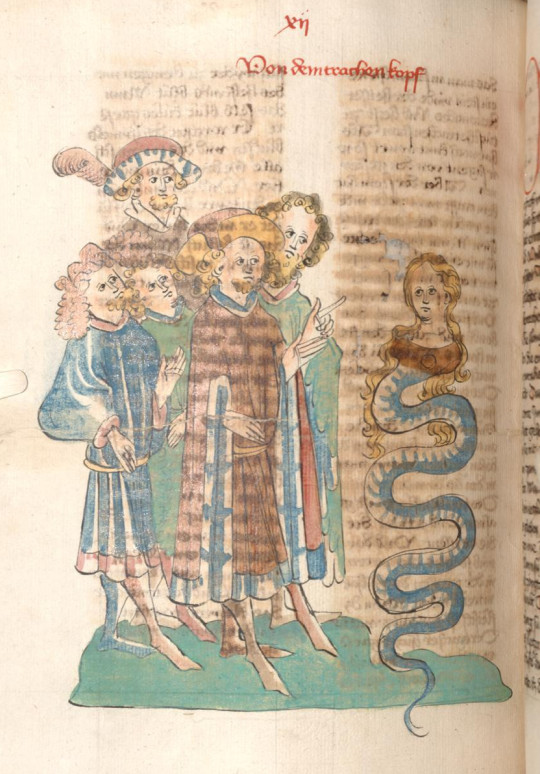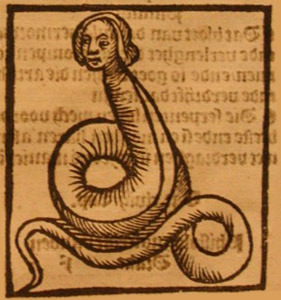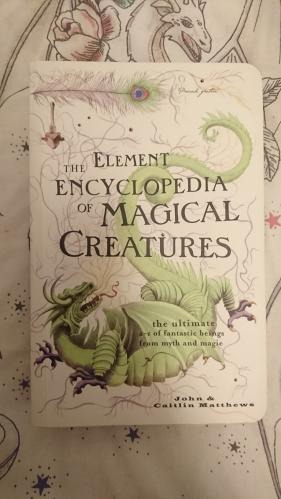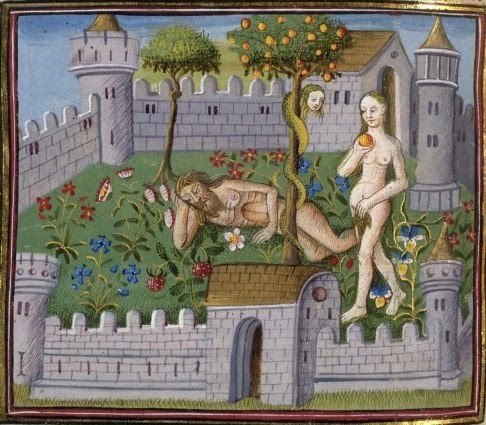#draconcopedes
Explore tagged Tumblr posts
Text


#art#illustration#draconcopedes#snakes#serpents#hortus sanitatis#16th century#creatures#medieval art#the garden of health#eve#myths#medieval monsters#language#bestiary#illuminated manuscript
148 notes
·
View notes
Text

draconcopes (trachenkopf)
in a copy of konrad von megenberg's "buch der natur", illustrated by the workshop of diebold lauber, alsace, c. 1440
source: Frankfurt, UB, Ms. Carm. 1, fol. 191v
#15th century#buch der natur#konrad von megenberg#diebold lauber#trachenkopf#drachenkopf#draconcopes#draconcopedes#hybrids#serpents#medieval art
395 notes
·
View notes
Text
Mythic Creatures by Culture & Region
Part 6: Medieval Europe
Global list & overview here.
This list still needs revising, because I didn't distinguish French, German, Italian and Spanish folklore (Catalan folklore is independent, because I support Catalonian independence haha). Some European folklore has already been listed in part 3 and 4 and 5 or will be listed in future in connection with religious culture.
Here are some links to websites with European creatures that I didn't all list: https://bestiary.ca/beasts/beastalphashort.htm
Medieval Europe Fish: http://www.godecookery.com/ffissh/ffissh.htm
Medieval Europe Plants: http://www.godecookery.com/mythical/mythical.htm
Abyzou; Aegipan in medieval bestiaries, based on Pliny the Elder; Aitvaras from Lithuania; Alberich in Thidrekssaga written in 1250 in Norway, possibly based on a Plattdeutsch original (also appears in German Nibelungenlied from 1200 in Passau, Bavaria and Ortnit from 1230s Germany, Strassburg; Alerion only 1 pair of these birds exists at a time, bestiaries and heraldry; Alp German; Alphyn; Amadís de Gaula made some time before 1508, contains the giant Endriago, a monster born of incest who exhales a poisonous gas and whose body is covered in scales and Urganda the Unknown: Sorceress who protects Amadís; Amphiptere, word is Greek, found on French coats of arms between 1300 and French Revolution. Possibly found in medieval bestiaries as an African animal (anhinga)? Winged snakes of Arthurian legend. Terrible Wikipedia page.; Anguane Italy; Anjana Spain; Antichthones; Arquetu; Askafroa German "Eschenfrau"; Aspidochelone referenced as Jasconius; Atlantes (sorcerer); Aufhocker; Augenbrand;
Badalisc; Bahkauv Aachen; Balaur Romanian, multi-headed dragon; Baldanders; Baphomet; Barabao; Barnacle Goose; Barstuk; Basilisk; Beast of Gévaudan; Beerwolf; Befana; Belsnickel; Bergmanli; Bergmönch; Bicorn; Bieresel; Big Ghoul (dragon); Biscione; Bishop Fish 2 visits, 1 in 1531; Bisterne Dragon; Black Dog; Black Panther; Blemmyes; Blue Ben; Blue Lady of Verdala Palace; Bonnacon (Pliny the Elder); Borda; Bragmanni; Brazen Head; Broxa; Bucentaur; Buckriders North Belgian and South Dutch; Buschgrossmutter; Buschweibchen; Butatsch Cun Ilgs; Butzemann;
Caballucos del Diablu; Caelia; Caladrius; Careto; Cerastes; Cheval Gauvin; Cheval Mallet; Chichevache; Chromandi; Cinnamologus; Coco; Cocollona; Cola Pesce; Crocotta; Cuegle; Cuélebre; Cynocephali;
Dahu; Dahut; Dames Blanches; Dames Vertes; Death; Demoiselles Blanches; Dipsa; Dolphin; Doñas de fuera; Drac; Draconcopedes; Dragon; Dragon of Beowulf; Dragon of Mordiford; Dragons of St. Leonard's forest; Drake; Drapé; Drude; Duende; Dwarf ; Dwarfs, Dwarves;
Easter Bunny; Ekke Nekkepenn; Elegast; Elemental; Elwetritsch; Emmet Giant Ant; Enchanted Moura; Enfield; Erchitu; Erdhenne; Erdluitle; Erlking; Ewiger Jäger;
Fáfnir; Familiar; Fänggen; Farfadet ; Farfadets; Fasolt; Fates; Father Frost; Fées; Feldgeister; Ferragut; Feuermann; Fish-man of Lierganes; Follet; Folletti; Frau Holle; Frau Holunder; French Mythic Creatures and Saints; Freybug;
Gabija; Galehaut; Galgemännlein; Ganna; Gargoyle; Gatipedro; Gayant; Gegenees; Giane; Glatisant; Gnome; Goblin ; Goblins; Golden Goose; Goldenhorn; Gorgades; Graoully; Guajona; Gudrun; Guivre; Gütel;
Hans von Trotha; Haymon (giant); Headless Horseman; Heimchen; Heinrich von Winkelried; Heinzelmännchen; Hercinia; Hey-Hey Men; Hinzelmann; Hircocervus also Greek & Roman; Hödekin; Homunculus ; Homunculi; Houles fairies;
Ichneumon; Irrwurz;
Jaculus; Jean de l'Ours;
Karnabo; Ķekatnieki Latvian mask processions; King Goldemar; King Laurin; Klabautermann; Klagmuhme; Knecht Ruprecht; Knight of the Swan; Knights of Ålleberg; Kobold; Kornbock; Korred Iberia, Britanny, Cornwall; Krampus; Kurents (Slovene mask processions);
La Encantada; Laima; Lampetho possibly based on Roman accounts of Lampedo; Lauma; Laúru; Legendary Horses in the Jura; Legendary Horses of Pas-de-Calais; Leontophone; Lepus cornutus; Lietuvēns; Lindwurm; Loch Ness Monster; Lou Carcolh; Lucius Tiberies (vs King Arthur); Lutin; Lutins Noirs; Lutzelfrau; Lycaon; Lyncetti;
Machlyes; Mahound; Mandragora; Manticore; Marabbecca; Mare; Massarioli; Muscaliet; Musimon; Myrmecoleon; Nachtkrapp; Nachzehrer; Naimon; Matagot; Mazapégul; Melusine; Monaciello ; Monacielli; Monopod; Moss People; Mouros;
Nimue; Nixen aka Nixie ; Nixies; Norggen;
Oj��ncanu; Oksoko (3 headed eagle in heraldry & 3 headed bird in alchemical texts); Ork; Orphan Bird; Ortnit; Ouroubou;
Pamarindo; Pandi; Pantheon_the_creature; Panther; Pard; Peluda; Perchta; Père Fouettard; Petermännchen; Phoenix; Picolaton; Púca;
Quiet Folk; Quinotaur;
Ramidreju; Rasselbock; Revenant; Reynard; River Women; Rougarou; Rüdiger von Bechelaren; Rumpelstiltskin;
Salamander; Salvanel ; Salvanelli; Salvani; Sandman; Santa Compaña; Satyrus; Schrat also Slavic; Sciritae; Scitalis; Sea-Griffin; Sea-Lion; Sebile; Selige Fräulein; Serván; Sheela na Gig; Skrat; Straw Bear; Strix; Struthopodes; Swan Maiden; Syrbotae;
Tarand; Tarasque; Tatzelwurm; Termagant; The Devil Whale broad category, includes modern accounts and Sindbad; The Imp Prince; The Legend of Ero of Armenteira; The Nixie of the Mill-Pond; The Prince Who Wanted to See the World; The Swan Queen; Theow; Thyrsus (giant); Tooth Fairy; Trasgo; Tree Elves; Trenti; Türst; Tyger;
Uhaml;
Vegetable Lamb of Tartary; Venediger Männlein; Ventolín;
Weiße Frauen; Werewolf; White Lady ; White Ladies (fae); Wichtel; Wiedergänger; Wight; Wild Hunt; Wild Man, Wild Woman ; Wild Men, Wild Women; Wind Folletti; Witege; Witte Wiver; Wolpertinger; Wolves in heraldry (search wiki page for word calopus);
Xana;
Yale; Ypotryll;
Žaltys Lithuanian;
allegedly medieval
Lorelei; Rompo; Squasc
Belgium
Druon Antigoon; Lange Wapper; Zitiron
Brittany
Amadís de Gaula (Gaula, the fictional part of Brittany); Ankou; Bugul Noz; Fions; Groac'h; Iannic-ann-ôd; Jetins; Korred; Korrigan ; Korrigans; Les Lavandières; Malo (saint); Margot the fairy; Morgen; Morvarc'h; Tréo-Fall; Yan-gant-y-tan
Byzantium
Abyzou; Gello
Catalan
Aloja; Banyoles monster; Catalan Creatures; Comte Arnau; Dip; Home dels nassos; La Guita Xica; Marraco; Minairó; Muladona; Negret; Nitus; Pesanta
Celtic mainland
Dusios Gaul (known through Greek, Roman and medieval sources); Les Lavandières; Púca; Sovereignty goddess also Irish; Swan Maiden; Trasgo; Werewolf
Dutch
Alven; Ellert and Brammert (giants); Kabouter; Swan Maiden; Witte Wieven
Estonia
Akka, also Finland and Sami; Dragon of the North; Ebajalg; Estonian Creatures; Kalevipoeg; Kratt ; Kratid; Maa-alused; Skrat; Toell the Great; Vanapagan
Finland
Aino; Ajatar; Akka, also Sami and Estonian; Antero Vipunen; Etiäinen; Firefox; Haltija; Heikki Lunta; Hiisi; Iku-Turso; Lemminkäinen; Lempo; Maanväki; Menninkäinen; Nine Diseases; Nuuttipukki; Otso; Paasselkä devils; Piru; Soul Components_Finnic Paganism; Swan Maiden; Syöjätär; Tapio; Vellamo
Germanic
Albruna Germanic seeress attested by Tacitus; Cimbrian seeresses mentioned by Strabo; Gambara; Ganna; Hooded Spirits; Idis; Matres and Matronae; Plusso Wendish = Slavs of North Germany; Swan Maiden; The Woman of the Chatti; Thiota; Veleda; Waluburg; Wurm
Roma
Mullo; Ursitory; Vampire pumpkins and watermelons
Sami
Akka also Finland and Estonia; Ruohtta; Stallo; The Elf Maiden;
Venice
Winged Lion (St. Mark), Venediger Männlein (allegedly from Venice, not on Wikipedia)
Renaissance
Allocamelus in Edward Topsell and among English companies; Hippogriff; Hircocervus in Edward Topsell, based on earlier sources; Ipotane first attested with John de Mandeville; Irrwurz; Jenny Haniver; Lampago maybe medieval not renaissance???; Lepus cornutus; Lizard Fairy; Mephistopheles; Oberon; Orgoglio; Pier Gerlofs Donia; Pyewacket (familiar spirit); Queen Mab; Satyress; Sea Monk; Succarath; Sylph; Teutobochus; Three Witches; Titania; Undine ; Undines; Vegetable Lamb of Tartary; Werewolf; Wild Man, Wild Woman ; Wild Men, Wild Women
Enlightenment
Jacques St. Germain; Terrible Monster maybe real??? Romanticism; Lorelei; Warlock
Notify me please if there are mistakes or if these beings should have a disclaimer not to be used in art or fiction writing.
#mythic creatures#mythic creature list#legendary creatures#legendary creature#legendary being#legendary beings#creature list#legendary creature list#monster list#list of monsters
0 notes
Text
Draconcopedes

Name: Draconcopedes
Type: Folkloric
Culture of Origin: Medieval Europe
Description: A serpent with the head (and often breasts and arms) of a woman.
Myth: N/A
Facts:
In some versions of the story, the Serpent in Eden is depicted as having the head, breasts, and arms of a woman.
Some claim this serpent is Lilith, Adam’s first wife.
Albertus Magnus says the Draconcopedes is of the dragon genus, and describes it with the unbearded face of a man.
13 notes
·
View notes
Text
Write Your Own Adventure Lesson 9: Research for Your RuneQuest Adventure
This lesson discussed what research might need to be done for an RPG adventure, both of the fictional setting and of relevant details taken from the real world, and asked participants to write down what research they would have to for their particular adventure. Here's what I wrote:
I've already been doing some research about Glorantha to write my adventure. In particular, I wanted to find out as much as I could about the Lismelder Tribe and the Upland Marsh. There's not that much about either in seventh edition materials (though the Gamemaster Adventure book does have some information on the Lismelder tribe), but there was more in earlier editions, in Tales of the Reaching Moon #19 and Wyrm's Footprints #15, so I skimmed through those sources for anything that looked relevant or useful. (I also asked questions on the Chaosium forums and got very helpful responses from the posters there.)
Again, it turns out I missed some important material about Ten Spear, so I apparently didn't research it as well as I thought. Oh well. Moving on...
As for some real-world topics of research, well, the RuneQuest Roleplaying in Glorantha core book mentions that the lismelder Tribe "are famous for their great beer", so I figured maybe Ten Spear could have a brewery. But I really don't know anything about how beer was brewed in the Bronze Age (heck, I don't know anything about how beer is brewed today), so that's something to research.
Oh, yes, and (at least) one more thing. I wanted the spirit in the shard to be the spirit of a long-dead Beast Man of an extinct species… but I hadn't decided on what that species was. With the exception of the ducks, the established kinds of Beast Man of Dragon Pass are all based on creatures from classical mythology and/or medieval beliefs, so I wanted to find some other suitable part-human mythical creature that hadn't been used, but I hadn't settled on what yet. (I can think of a few—the onocentaur, the cynocephalus, the sphinx—but I'm sure there are others I'm forgetting or don't know about.) Oh, hey, and I just found one that I think would work perfectly: the draconcopedes. A snake with a human head mentioned in some medieval bestiaries. That'll do. At least, assuming it checks out when I verify the sources and make sure it's not something made up by some Wikipedia editor.
Hm, wait, on second thought, maybe not. Glorantha isn't a medieval world, after all; it's a Bronze Age world, and while the manticore, for instance, may have been best known from medieval bestiaries, its roots go back to ancient Persia. The earliest references to the draconcopedes seem to be from the Middle Ages, so it's not really old enough. I'll keep looking.
Oh, there's the lammasu, of course. Eh, maybe, but it's not really grabbing me. The buraq… hm.
Hm, here's a part-human part-goat creature, but that may be too close to the broo: https://www.eranshahr.com/myths/ghara-gharnagh
There's also this turtle-person from the same site: https://www.eranshahr.com/myths/ab-laku
Wait, aren't there those ancient cave paintings of antelope-man "therianthrope" figures? Oh, yeah, here's what I was thinking of: https://www.labrujulaverde.com/en/2020/06/the-strange-and-controversial-prehistoric-sorcerer-of-the-cave-of-the-trois-freres
Though apparently it's more controversial than I realized. Still, I'm just looking for an ancient myth to use for inspiration; I guess it doesn't matter too much if it's completely authentic. If I'm going for an extinct type of Beast Man, that might be a good fit. Of course, there isn't really an established name for this figure (aside from the clearly unusable "Sorcerer")… but I guess I could just call them "antelope men", and that would be fine. I'll tentatively go with that for now, though I'll keep my eye out for something I like better. (Hm, interesting, there are also cave paintings of bison-headed figures, apparently: https://www.faculty.umb.edu/gary_zabel/Courses/Phil%20281/Philosophy%20of%20Magic/My%20Documents/Therianthropes.htm Well, I think I'll stick with the antelope for now.)
As for the Bronze Age brewing, I found a few sites with some interesting information on that, including the "oldest known beer recipe" https://www.realmofhistory.com/2017/09/22/oldest-beer-recipe-mesopotamia-ninkasi/ , a description of discovered ruins of an ancient Green brewery https://www.livescience.com/61590-oldest-beer-in-greece.html and an article about Bronze Age beer-brewing in Ireland https://www.irishtimes.com/culture/unearthing-bronze-age-brewing-1.953684. Oh, and this could be useful: a video of a reconstruction of brewing techniques from a 3800 recipe https://ne-np.facebook.com/BeoirFestonline/videos/recreating-a-bronze-age-beer-for-the-modern-world/708828930137367/ Okay, I think there's enough here I can get a sufficient idea of what a Bronze Age beer brewery may have been like.
Oh, yes, one more thing. I was going to have beekeeping as one of the village's more significant industries, so… I guess that's another thing to research. Though this page looks like a promising start: https://www.agriculturalmuseums.org/2020/04/16/how-has-beekeeping-changed-over-time-an-archaeobeekeeper-and-an-archaeological-open-air-museum-in-germany-showcase-pre-and-proto-historic-beekeeping-methods/ Oh, and here are a few more documents I can look at: https://www.evacranetrust.org/uploads/document/2949b8a5ef604548975b4b0eb7d9e738cd654435.pdf https://www.apicultural.co.uk/tears-of-re-beekeeping-in-ancient-egypt
(Okay, yeah, I could make those links clickable in this Tumblr post but, eh, it's taking me long enough to make all these posts as it is, and I need to spend time actually working on the adventure. You can always copy and paste the links if you really want to see where they go.)
2 notes
·
View notes
Text
Book Review: The Element Encyclopedia of Magical Creatures by John and Caitlin Matthews

The Element Encyclopedias are a series by Harper Element, containing books on Secret Signs and Symbols, Birthdays, magic (Encyclopedia of 1000 and 5000 spells), Secret Societies, Witchcraft, Ghosts and Hauntings, the Psychic World, Vampires and of course, Magical Creatures. These Encyclopaedias cater to niche interests on the weird and wonderful. They aim to deliver a factual overview of particular subjects, covering as many different viewpoints from as many different cultures as possible.
The Element Encyclopedia of Magical Creatures is a compact volume; most entries are only a sentence long. The limitation of an Encyclopaedia format is that the entries are in alphabetical order by only one spelling of their name, which means the author chooses name spellings they think are best and stick with them – for example Pai Lung is used but Bailong is not – which means if a reader is looking up a creature by one specific spelling they might not be able to find it. This issue is solved by other, similar books by having multiple entries for a creature, for example an entry saying ‘bailong’ would say ‘see Pai Lung’ to redirect the reader to the correct chapter. However, the choice to NOT do this in the Element Encyclopedia means that the book can be a small volume jam-packed with information. This decision means the book is well formatted and neat, easy to read with a good font size, and a good place to find out about a lot of dragons.
If a dragon has a full story to it, it may not be recounted in full; for example the entry for ‘Bida’ simply reads ‘Bida is an African dragon, which appears in the West African Epic of the Dausa’. However, enough information is given so that the reader has a few terms to google (“bida dragon epic of the dausa” for example). Again, I think the brevity of the book can act as a benefit, as the book is very easy to read and accessible compared to some more thorough books with smaller font sizes and bigger book sizes.

For further research, the bibliography is eight pages long (two columns per page) and mentions not only books, but articles from magazines (the Fortean Times, for example, is a magazine which can dedicate many, many pages to interesting mythology topics).
Quick note on the reading age; there is some sexual content in the story of the Egyptian god Set and maybe in a few other entries. These mentions are only where they are pertinent, and they are written in a factual manner, but if you buy this book as a gift for a young reader be aware of whether this content is appropriate for them.
Dragons covered by The Element Encyclopedia of Magical Creatures are:
Abaia, Afanc, Agathodemon, Ahi, Aiatar, Aida Hwedo, Aitvaras, Akhekhu, Alklha/Alicha, Altamaha-Ha, Amphithere, Amphisbaena, Amphisien, Anamtaboga, Anata Sesha, Angont, Ao Chin, Ao Kuang, Ao Ping, Ao Shun, Arassas, Asdeev, Aspis, Ayida, Azi Dahaka, Basilic, Basilisk, Beithir, Bida, Bistern Dragon, Bobbi-Bobbi, Bujanga, Bunyip, Burach Bhadi, Buru, Camoodi, Cecrops, Cerastes, Cetus, Champ, Ch’ang O, Chang Lung, Chi Lung Wang, Chudo-Yudo, Cipactli, Cirein Croin, Cockatrice, Con-Rit, Da, Dabbat, Dahak, Damballah Wedo, Dan Ayido Hwedo, Ddraig Goch, Derketo, Dev, Dhrana, Dhumavarna, Draco, Draconcopedes, Dracontides, Dragon, Dragon-Horse, Drake/Fire-Drake, Echeneis, Echidna, Eight-Forked Serpent of Koshi, Elbst, Falak, Fire Dragon, Fire-Drake, Fu-Hsi, Fu-T’s’ang, Gaasyendietha, Ganareva, Ganj, Gargouille, Glycon, Glyryvillu, Gong-Gong, Gorynich, Goryschche, Gou Mang, Gowrow, Great Horned Serpent, Great Lynx, Great Serpent of Hell, Gucumatz, Guita, Gurangnatch, Guyascutus, Gwiber, Hai Riyo, Hatuibwari/Figona, Herren-Surge, Hordshyrde, Horned Serpent, Horomatangi, Huru-Kareao, Hydra, Hydrus et cetera
(I tried to list every dragon by flicking through the book page-by-page and writing them down but that took a while – hopefully the dragons from A to H listed here gives you an idea on how thorough and extensive this book is!)(spellings are as they are in the book, I’ve seen herren-surge spelled more often as herensurge)
If this book appeals to you it can be found here:
Thriftbooks: https://www.thriftbooks.com/w/the-element-encyclopedia-of-magical-creatures-the-ultimate-a-z-of-fantastic-beings-from-myth-and-magic-the-element-encyclopedia_john-matthews_caitln-matthews/390280/#isbn=0007850506
ePDF https://epdf.pub/the-element-encyclopedia-of-magical-creatures-the-ultimate-a-z-of-fantastic-bein.html
#Dragon Books#Book Review#Caitlin Matthews#John Matthews#Elemental Encyclopedia#The Element Encyclopedia of Magical Creatures
9 notes
·
View notes
Text
Mythology & Fantasy Monsters Mega-Post II
Fallen Angel (Angel)
Gulyabani (Shifter)
Tepegöz (Ogre)
Tepegöz, Polyphemus (Ogre)
Flaga (Spirit)
Devil (Angel)
Devil, Crossroads Demon (Demon)
Devil, Archon (Angel)
Devil, Vėlė (Spirit)
Emmet (Vermin)
Emmet, Pismire (Vermin)
Ass-Bittern (Hybrid)
Humā Bird (Bird)
Humā Bird, Double Headed Griffin (Hybrid)
Humā Bird, Paradise Bird (Bird)
King Charles Parrot (Hybrid)
King Charles Parrot, Rabbit Bird (Hybrid)
Polypus (Vermin)
Polypus, Sea Scorpion (Vermin)
Black Annis (Humanoid)
Black Annis, Saalua (Spirit)
Kirata (Humanoid)
Drude (Faery)
Drude, Boo Hag (Spirit)
Drude, Bakhtak (Demon
Drude, Churel (Faery)
Brahmaparusha (Undead)
Brahmaparusha, Asiman (Spirit)
Ubu King (Demon)
Tennin (Faery)
Tennin, Yosei (Faery)
Berehynia (Faery)
Berehynia, Azukitogi (Humanoid)
Sea Troll (Beast)
Sea Troll, Ri (Merfolk)
Sea Troll, Moruadh (Merfolk)
Sea Troll, Orc-Thyr (Merfolk)
Sea Troll, Roane (Shifter)
Tasaday (Faery)
Snouter (Vermin)
Snouter, Sniffling Snouter (Vermin)
Snouter, Nasobame (Vermin)
Snouter, Tyrannosasus (Beast)
Snouter, Mamontops (Beast)
Duppy (Elemental)
Duppy, Bogle (Faery)
Duppy, Woodarjee (Faery)
Pennines Pterosaur (Drake)
Moon-Eyes (Alien)
Moon-Eyes, Melon Head (Humanoid)
Gajasimha (Hybrid)
Catfish (Hybrid)
Catfish, Leonine Whale (Beast)
Lybbarde (Beast)
Lybbarde, Pantheon (Hybrid)
Lybbarde, Tyger (Beast)
Minocane (Humanoid)
Stellione (Reptilian)
Allocamelus (Beast)
Crowned Lion (Beast)
Crowned Lion, Manticora (Beast)
Almas (Humanoid)
Almas, Yeren (Humanoid)
Almas, Hibagon (Beastman)
Biscione (Reptilian)
Biscione, Draconcopedes (Hybrid)
Moura Encantada (Faery)
Apotharni (Beastman)
Apotharni, Hippocentaur (Hybrid)
Apotharni, Quaraphon (Beastman)
Apotharni, Polkan (Hybrid)
Apotharni, Lapith (Beastman)
Ennedi Tiger (Beast)
Ennedi Tiger, Dilali (Beast)
Ennedi Tiger, Mamaimé (Beast)
Ennedi Tiger, Vossoko (Hybrid)
Ennedi Tiger, Gassingram (Beast)
Yamabushi (Demon)
Yamabushi, Shikigami (Faery)
Sereia (Merfolk)
Sereia, Tchimose (Shifter)
Sereia, Gunnuhver (Undead)
Zanryū Nipponhei (Undead)
Rosmarus (Beast)
Rosmarus, Selamóðir (Beast)
Skeljúngur (Beast)
Skeljúngur, Sverðhvalur (Beast)
Skeljúngur, Taumafiskur (Beast)
Cherub (Angel)
Cherub, Cupid (Deity)
Cherub, Putto (Faery)
Tzimisce (Undead)
Tzimisce, Vozhd (Construct)
Tzimisce, Szlachta (Undead)
Bogatyri (Ogre)
Vampire Hunter (Humanoid)
Skellring (Humanoid)
Morpheus (Deity)
Morpheus, This Man (Spirit)
4 notes
·
View notes
Photo

Draconcopedes
In many medieval variants of the Story of Eden, it was not a snake that tempted mankind in the Garden, but instead a dragon with the head, face, and sometimes breasts of a woman.
Despite the name, roughly meaning ‘dragon with feet’, this creature invariably has the body of a snake or wyrm.
40 notes
·
View notes